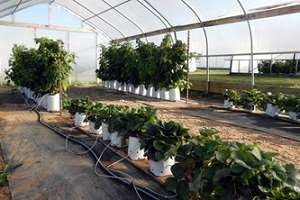SCRI High and Low Tunnel Berry Project Update #1—information on growing strawberries and raspberries in containers.
Periodically growers have asked for information on growing strawberries and raspberries in containers. Thanks to our Specialty Crop Research Initiative (SCRI) high tunnel project, we can share some experiences on what worked for us this past year or so.

We started using a containerized system in our high tunnels because soil variability at Penn State’s high tunnel research site was an issue. The high tunnels had been used to grow many different crops over the past 17 years and so over time, the nutrient levels in each tunnel became quite variable. This was a problem for our research, as we are testing different plastic coverings for the tunnels and we wanted to make sure we were correctly attributing any effects to the plastics, not to differences in the soil in each tunnel.
In 2015-16, we compared 4 different media types for growing day-neutral strawberries, and 2 different fertilization regimes. In this experiment, we tried the type of bag used for coir gro-slabs – these are white-on-black plastic “sleeves” that lie horizontally on the ground and, when filled with media, are only 4 to 5 inches high.
The media we compared were coir, Metromix 360, a mix that was a 2:1 ratio of peat:perlite, and a 2:1:1 mixture of peat:perlite:coir. We found that since the sleeves are not very deep, it helped to have a well-drained mix, because there wasn’t much room for error when it came to over-watering. Top growth and root growth were best in the 2:1 peat:perlite mix, and the root growth was truly amazing – just extracting the plants from the bags to take measurements was a challenge because they were so packed with new roots. The flip side was that bags with the 2:1 peat:perlite mix were the first to dry out, and while part of this effect was due to a lower water-holding capacity, the large root systems could have been pulling out a lot of water.
We also compared fertilizer mixed into the media to a constant feed of a complete soluble fertilizer at 100 ppm N. When we mixed the fertilizer in, we used an older recipe which I won’t give here since it wasn’t the best option! Because our water is from a well and is really high in pH and bicarbonates, we opted for an 18-18-18 complete soluble fertilizer made for this situation (Peters® Excel pHLow™), which dropped the water pH from 7.6 to 6.6. I should also point out that we did not add any lime to the media – we figured we’d get plenty of that from our water. Fertilizer in the mix resulted in much more plant variability than the constant-feed treatment, and plants being watered with the soluble fertilizer grew larger regardless of the type of media used.
In 2016-17, we opted for deeper containers that would provide a wider margin for error when watering. So we used 1-gallon grow-bags for strawberries, and also 3-gallon grow-bags for raspberries. We also found the results of work in Florida and Arizona that showed growing strawberries in deeper containers worked better than using more shallow ones. The difference was only a couple of inches. In 1-gallon grow-bags, the media was 6 to 7 inches deep, but it was enough of a difference to make watering easier. Both the strawberries and raspberries grew extremely well overall.
In 2016-17, we also tried a different fertilizer made for water high in bicarbonates (Plant Marvel 20-7-20), and that worked well, too. We may eventually end up acidifying our water, but for the time-being just using fertilizers made for high-bicarbonate water worked. What is important is to make sure that the fertilizer is dissolved completely, and also that a precipitate isn’t forming after the fertilizer solution stands for a while. In the past, when we tried more commonly-used soluble fertilizers, precipitates were probably forming, as there was often a fine white powder in the bottom of the container. At the time, we had thought this was calcium phosphate, but we were also having deficiencies of iron and zinc, so possibly other complexes were also forming as well.
So, as a recap, what worked for both raspberries and strawberries was a 2:1 peat:perlite mix; with the plants receiving either of the 2 complete fertilizers (18-18-18 or 20-7-10, both made for an irrigation source that is high in bicarbonates) at 100 ppm N. Strawberries in 1-gallon grow-bags, and raspberries in 3-gallon grow-bags worked well.
In future months this winter, we’ll provide updates on other parts of the project as we get the data entered and analyzed.
Source: psu.edu